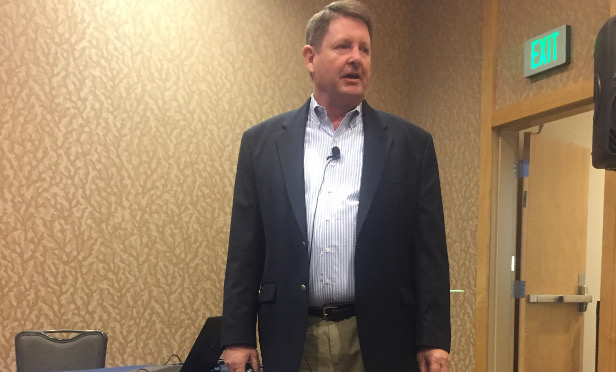 Dowrey said drones are quicker, safer and most cost-effective than traditional site-assessment methods.
Dowrey said drones are quicker, safer and most cost-effective than traditional site-assessment methods.
SAN DIEGO—Reduced risk, lower costs and better data are a few of the perks property managers are gaining when they use drones to examine property, Osprey Assessments’ Gordon Dowrey told IREM Fall Conference attendees here Friday. Dowrey led one of the many iTalk sessions (his was titled “What’s Up With Drones?”) during the conference that introduced attendees to a variety of subjects and succinctly boiled them down to 18-minute presentations.
Dowrey said drone technology is catching on, with 300,000 drones registered with the FAA as of January and an expected 90 billion by 2025. He said property managers who use drone technology to inspect roofs and facades reduce the risks associated with going over the side of buildings, which impacts insurance rates and accidents. The costs of scaffolding a building in order to inspect it the traditional way are high, but using drones can reduce these costs by up to 50%. In addition, the videos obtained by using drone technology can serve double duty if they’re used for business-marketing purposes.
But perhaps the most compelling reason for property managers to use drone technology is that they can obtain better data, Dowrey said. One can obtain 100% coverage of a building using this technology, which offers infrared images and overall more information than traditional processes. “Drones are quicker, safer and more cost effective than traditional methods.”
Of course, there are some considerations to keep in mind when using drone technology. In some places, you aren’t allowed to fly a drone, such as close to an airport or too high, so you need to be familiar with US airspace and regulations impacting drone operations. There are also risk-management considerations associated with operating the drone itself, such as losing control of the drone, interference from antennae and false data from GPS-reflected buildings.
However, there are capabilities with drones that you would never be able to achieve with traditional methods, such as getting hi-res images and zooming in close. These can allow property managers to save money by knowing the exact portion of a roof that needs to be fixed rather than having to replace an entire roof and being able to plan for future maintenance.
Dowrey recommended knowing the criteria for identifying and selecting drone-service providers. The most important takeaway: Be sure you can supply actionable data with the drone; otherwise, the service is cool but useless.

















 Copyright © 2024 ALM Global, LLC. All Rights Reserved.
Copyright © 2024 ALM Global, LLC. All Rights Reserved.